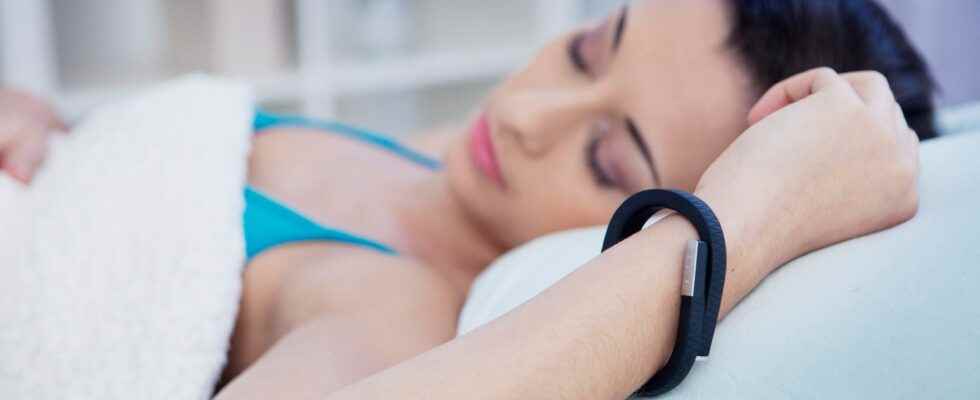It is a small pebble with enticing promises. Placed on the bedside table, it projects a blue light on the ceiling which should normally help us fall asleep better. Unfortunately for users, this azure halo promotes enlightenment instead. “From a scientific point of view, there is a manifest error of conception here”, is surprised Maxime Elbaz, technical director of the sleep and vigilance center at the Hôtel-Dieu hospital (Paris). , the object continues to sell. Videos even praise its effectiveness. Proof that the market for connected objects is still akin to a vast bazaar in which dubious products rub shoulders with promising solutions.
In recent years, many devices attempting to measure sleep have appeared: watches, bracelets, rings, headbands, mattresses… For brands, monitoring our nights is clearly becoming a marketing issue. But faced with this avalanche of coaching products and apps to support them, validation studies remain rare. “The brands financing this kind of work can be counted on the fingers of one hand”, notes Maxime Elbaz. Another difficulty: many evaluations suffer from methodological biases. They therefore do not meet the quality standards of the scientific world.
However, some serious work allows us to see more clearly. A recent meta-analysis shows, for example, that connected objects overestimate the total sleep time by around 30 to 35 minutes per night, compared to polysomnography, a medical protocol serving as a reference. Connected objects also overestimate the quality of sleep by around 8%. Proof that they are not all able to correctly distinguish the different stages of sleep (slow deep, paradoxical, etc.). “It will eventually happen, believes cardiologist Pierre Escourrou. But for the moment, the advertisements are exaggerating a little”. A classic in the field of technology.
These products that stand out
“On the Internet, you will easily find headbands with integrated headphones. These produce sounds or read stories to help you fall asleep. However, this is more of a gadget than anything else. Just like whispers ( ASMR) that we listen to in bed. No study proves that it works”, specifies Maxime Elbaz. Already in 2016, a French start-up claimed with its Dreem headband to be able to improve deep slow-wave sleep through auditory stimulation. It did not work. Today, the company has reoriented itself and has more reasonable ambitions: to develop a mini polysomnograph capable of measuring sleep with precision.
But these broken promises do not prevent certain products from standing out and offering interesting results. This is the case, for example, of the Oura ring. Designed by former Nokia engineers, acclaimed by Prince Harry, this discreet device, which is already in its third version, is one of the most accurate for measuring the quality and quantity of sleep.
The French connected Moona over-pillow also obtains promising results by working on the body’s core temperature. This needs to drop a degree to give our sleep system the instruction to start. The device therefore cools the neck thanks to a water circuit and a “pod” placed on the bedside table, which takes care of maintaining the right temperature.
“We found that with our device, postmenopausal women gained more than 35 minutes of sleep time after ten nights. The quality of their nights is also improving,” says David Stoikovich, co-founder and president of Moona.
“All these developments are good news. In the future, patients will become actors of their disorders such as insomnia or sleep apnea. They will self-assess with an app, a watch or a connected ring , then go see a doctor with their data”, estimates Maxime Elbaz. Even if for the moment, the sharing of the results with health professionals is not yet developed. The use of minimally invasive devices will also make it possible to monitor people over several nights and therefore improve the detection of possible pathologies.
A radar on the bedside table
“There are beginning to be very high-performance products, thanks in particular to progress in artificial intelligence”, confirms Pierre Escourrou. The Sunrise device, for example, detects sleep apnea from sensors placed on the chin. “It may seem surprising, but because of the efficiency of the algorithms, we arrive at performances quite comparable to those of polysomnography”, assures the doctor.
Another surprising example, tongue physiotherapy for sleep apnea is also beginning to develop in the United States and Spain. Here, the idea is to avoid certain muscles sagging by performing movements with the organ of taste while looking at your smartphone. This indicates the exercises to be done and checks whether they are well done. “It’s nothing outlandish and is based on scientific publications,” says Maxime Elbaz.
We are not at the end of our surprises. New technologies regularly arrive on the market. Thus, a radar placed on the bedside table now makes it possible to record sleep and respiratory movements with acceptable results. At the rate things are going, some devices should soon be reimbursed by Social Security, believe several specialists. The bricks are gradually being put in place: “Soon, apps will be labeled by the Ministry of Health. We can therefore download them with confidence”, warns Maxime Elbaz. But until then, doctors will have to be trained in these new digital tools. Because they tend to fall asleep… on their old practices.
